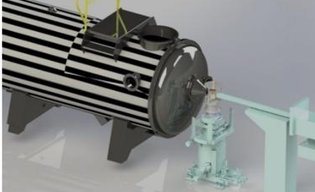de Oliveira-Silva, Rodrigo; Bélime, Agathe; Le Coeur, Clémence; Chennevière, Alexis; Helary, Arnaud; Cousin, Fabrice; Judeinstein, Patrick; Sakellariou, Dimitrios; Zanotti, Jean-Marc
In soft condensed matter, Small Angle Neutron Scattering (SANS) is a central tool to probe structures with characteristic sizes ranging from 1 to 100 nm. However, when used as a standalone technique, the dynamic properties of the sample are not accessible. Nuclear Magnetic Resonance (NMR) is a versatile technique which can easily probe dynamical information. Here, we report on the coupling of a low-field NMR system to a SANS instrument. We show that this original set-up makes it possible to obtain structural information and to simultaneously extract in situ on a same sample, long-range translational diffusion coefficient, T1T1 and T2T2 nuclear spin relaxation times. Such a feature is of major interest when a sample experiences a transient physical state or evolves rapidly. We illustrate the capabilities of alliancing these experimental methods by following the critical temperature-induced phase separation of a concentrated Poly(Methacrylic Acid) solution at its Lower Critical Solution Temperature. The characteristic size related to the domain growth of the polymer-rich phase of the gel is monitored by the evolution of the SANS spectra, while the dynamics of the sol phase (H2O and polymer) is simultaneously characterized by NMR by measuring T1T1, T2T2 and the diffusion coefficient. Great care has been taken to design a cell able to optimize the thermalization of the sample and in particular its equilibration time. Details are given on the sample cell specifically designed and manufactured for these experiments. The acquisition time needed to reach good signal-to-noise ratios, for both NMR and SANS, match: it is of the order of one hour. Altogether, we show that in situ low-field NMR/SANS coupling the NMR is meaningful and is a promising experimental approach.



